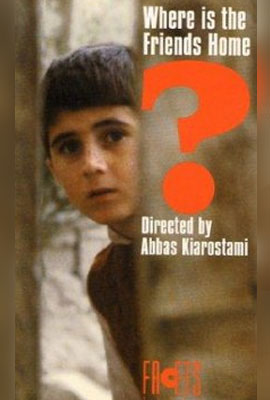
(1987)
directed by Abbas Kiarostami
In the very first scene of this extraordinarily sensitive film, we witness a child’s tears. Children have a keen sense of injustice. Perhaps adults are less sensitive to the sharp pain of injustice because they have experienced it more often. Our young protagonist feels his friend’s predicament with his whole being.
As often happens with the very best movies, the story is very simple. Ahmed has mistakenly taken his schoolmate’s notebook home. He must find his friend’s house and return the notebook. If he doesn’t succeed, his friend will be expelled from school. Ahmed knows his friend lives in the next village, but he has no idea of the exact address. Ahmed moves through a beautiful, poetic landscape and asks the same question over and over again, “Where is the friend’s house?”
The director, Abbas Kiarostami, is famous for the zigzag road motif that appears in his films and which symbolizes his characters’ journey through life. Ahmed follows a zigzag path between villages and the film takes on the character of a parable. It is a beautiful example of visual storytelling which is filled with poignant details. The film’s title was inspired by the following poem which is translated from Arabic:
The Avenue
The rider asked in the twilight,
Where is the friend’s house?
Heaven paused, the passer-by bestowed
The flood of light on his lips to darkness of sands,
Pointed to a poplar and said, “Near the tree
Is a garden-line greener than God’s dream
Where love is bluer than the feathers of honesty.
Walk to the end of the lane which emerges
From behind puberty, then turn towards
The flower of solitude and two steps to the flowers.
Stay by the eternal mythological fountain of earth
Where a transparent fear will visit you.
In the flowing intimacy of the space
You will hear a rustling sound and
You will see a child who has ascended
A tall plane tree to pick up chicks
From the nest of light. Ask him,
Where is the friend’s house?”
Sohrab Sepehri
Certain phrases in this sublimely beautiful poem help us understand the film. Certainly, Ahmed’s journey includes a “transparent fear.” Foremost is Ahmed’s fear of failing to find his friend’s house, but the journey itself is also fearsome for a child. Ahmed’s zigzag path is an example of the “flowing intimacy of the space” mentioned in the poem. The film is about making discoveries and cherishing what’s in the world. This poem helps us understand Ahmed’s vulnerability, his difficult journey and, finally, his incredible determination.
Along the way, Ahmed meets up with a carpenter who knows where his friend lives. The carpenter gives Ahmed some advice about life, some of it serious and some of it comical. When Ahmed tells the carpenter about his difficult journey, the carpenter says, “You should have come to see me immediately!” The carpenter gives Ahmed a flower which Ahmed places in his friend’s notebook. The flower represents friendship.
When he is unable to find his friend’s house, Ahmed is forced to come up with a solution. He simply does his friend’s homework in his friend’s notebook and turns it in. The closing shot in the film shows the teacher grading the friend’s homework. The homework is determined to be “excellent.” The teacher ignores the pressed flower between the pages. Only Ahmed and the viewer understand its significance.
Martin Scorsese, the renowned American film director, expresses the highest praise for the work of Abbas Kiarostami, “Kiarostami,” Scorsese says, “represents the highest level of artistry in the cinema.”